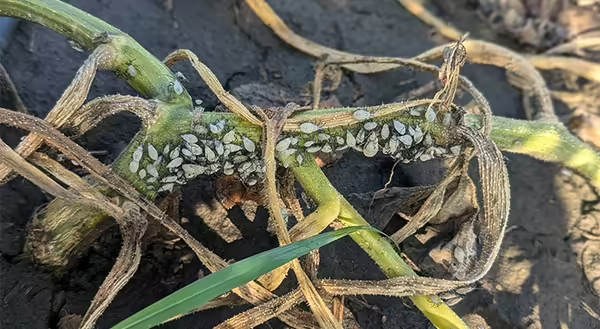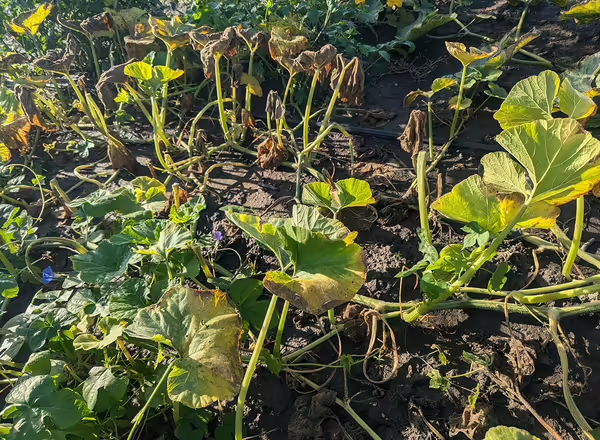
Farmers growing pumpkins and other cucurbit crops, like melons, might soon face a new challenge. A disease called Cucurbit Yellow Vine Decline (CYVD) was first detected in the late 1980s in Texas and Oklahoma. Since then, it has spread to the Southeast, Northeast, and Midwest regions of the United States. This disease is caused by a bacterium called Serratia marcescens, which is spread by squash bugs (Anasa tristis) when they feed on infected plants. It can take 2-4 weeks after infection for plants to show symptoms, which include yellowing of the vines and leaves, browning of the leaf margins, and wilting of the leaves. Severely infected plants will also have collapsed tissues, leading to the death of the plant; however, it is not uncommon for asymptomatic young plants to rapidly collapse without much warning.
Many popular crops, including pumpkins, squash, watermelon, and muskmelon, can get this disease. Luckily, cucumber plants seem to be safe from it. Unfortunately, CYVD can look like other plant diseases, such as bacterial wilt, fusarium wilt, and Phytophthora blight. This means it might have been spreading in Illinois for years without being noticed.
The best way to control this disease is to get rid of squash bugs on the plants. In the photo, pumpkin vines are covered with squash bug nymphs (Anasa tristis). The bugs use their mouthparts to suck out sap from plant tissues, leading to damaged plants. Feeding by large numbers of squash bugs can cause the vines to die, even without the disease present (photo credit: S. Hind, University of Illinois 2024). Since overwintering adult squash bugs can carry and spread the disease, it’s important to use insecticide sprays early to protect young plants if squash bugs are present. Farmers might need to spray multiple times during the growing season because young squash bugs (called nymphs) can also spread the disease. For more detailed advice, please check the Midwest Vegetable Production Guide for recommended products and thresholds or contact Illinois Extension Specialty Crops Entomologist Kacie Athey at 217-244-9916 or kathey@illinois.edu .

If you suspect that your cucurbit plants may be infected with CYVD, we’d like to hear from you! We are aiming to track the prevalence and diversity of this disease in Illinois. Please contact University of Illinois Assistant Professor Sarah Hind or send your plant samples for testing at the University of Illinois Plant Clinic. For an accurate diagnosis, samples should be collected when plants are in the yellowing stage before the tissues collapse.
WRITER: The following article was submitted by Sarah Hind, assistant professor in the Department of Crop Sciences, part of the College of ACES at the University of Illinois Urbana-Champaign.